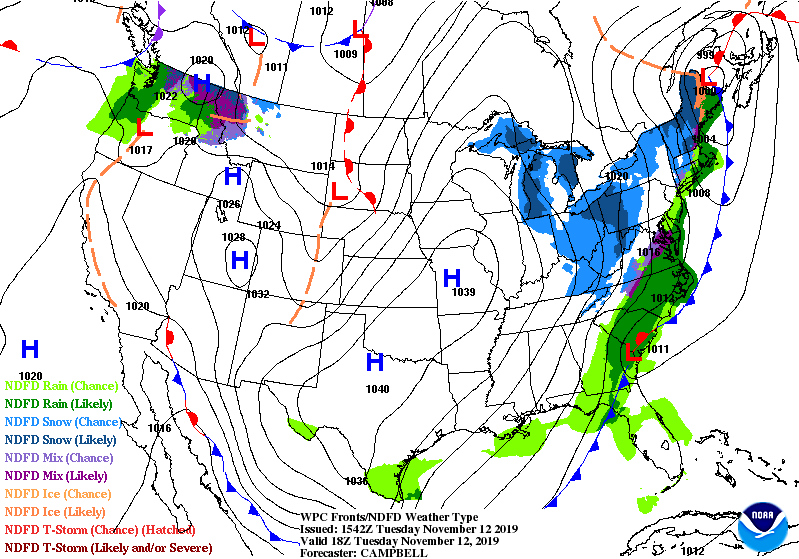Cold weather is hitting large swaths of the country this week and many could experience “record colds,” according to the National Weather Service (NWS).
The NWS forecasts “widespread record cold spreading from the Plains eastward toward the East Coast,” spreading across the eastern two thirds of the United States. The cold blast will last from Tuesday Nov. 12 until Thursday Nov. 14.
Around 240 million people will face winter weather warmings, watches, and advisories, according to CNN.
The Midwest and parts of northern New England already experienced snow on Monday, brought on by the “arctic air mass,” per the Associated Press.
Which parts of the country are getting hit with cold weather?
“Record cold” temperatures will spread in the Ohio Valley and down into the southern Plains on Tuesday as the “arctic airmass” moves south and eastward, according to the NWS. By Wednesday morning, “record low temperatures” in the teens and 20s can be expected throughout most of the East Coast, the Ohio Valley, and as far south as the upper Texas coast. The NWS says it will “feel like the middle of winter for these areas.”
NWS predicted on Monday that more than 300 daily-temperature record lows could occur between Monday and Wednesday.
The cold has reportedly caused school closures or delays across the U.S., including in the Midwest, the Mid-South and even Texas.
The NWS predicts that “Rain will likewise move rapidly across the Deep South and the Southeast today before the arctic chill arrives.”
According to the NWS, freezing temperatures have already hit the Midwest and are spreading as far south as Georgia and Texas.
Are any parts of the country expected to get snow?
The NWS also predicts “a wide large swath of snow” from “Tennessee Valley, along the Appalachians and upstate New York into northern New England.” But a lot of the snow is expected to “taper off” later on Tuesday.
Also on Thursday a separate disturbance of air will move across the Pacific Northwest and spread snow through the interior sections of the Northwest and the north Rockies, creating “light accumulations,” per the NWS. On Wednesday the “light snow and mixed precipitation” will likely move on top of the central Plains and reach the Great Lakes on Thursday.

On Monday, the NWS predicted as much as a foot of snow in the interior of the Northeast of the U.S., and warned that wet snow would mix with freezing rain in update New York to north-central New England.
What’s the forecast for later in the week?
The NWS predicts the cold front will lessen up by Thursday, and the high pressure system of cold air moves north.
Rain will likely continue in Florida through Thursday, and the Gulf Coast can also expect rain beginning Thursday as air moves north from Mexico, per the NWS.
Will the cold weather affect flights?
On Monday morning, an American Airlines flight landing at Chicago’s O’Hare airport slid off the runway because of icy conditions, according to WBBM-TV. No one was injured.
CBS 2 reports that over 1,200 flights were also canceled on Monday at Chicago’s O’Hare and Midway airports because of winter weather conditions.
According to FlightAware, 261 flights have already been canceled within the United States on Tuesday.
How can you stay safe in cold weather?
Cold air has already settled over the Plains and the Midwest of the U.S., and at least four people reportedly died on Monday in connection to the dip in temperature. Three women were killed in a crash near Charlotte, Michigan, according to WLNS.com, and authorities reportedly said weather conditions were a factor. The Associated Press reports that one person was killed after a trick sold on nice in Kansas.
So how can you stay safe? The NWS recommends you minimize travel and stay indoors when possible. Make sure to keep your pets inside. If you have to travel, check your car’s tire pressure, antifreeze levels and defroster before you leave. Also make sure to keep a winter survival kit in your vehicle, which should include a blanket, a flashlight, and a first aid kid.
The NWS recommends wearing layers of loose-fitting, lightweight warm clothing and a hat, as well as mittens rather than gloves. Try to cover your mouth to protect your lungs from the cold air and stay dry and out of the wind.
The NWS of Cleveland urges caution about the risk of a snow squall, or a sudden heavy snowfall with strong winds. If a driver is caught in a snow squall, NWS Cleveland urges drivers slow down, durn on their headlights, and avoid slamming the brakes.
More Must-Reads from TIME
- Donald Trump Is TIME's 2024 Person of the Year
- Why We Chose Trump as Person of the Year
- Is Intermittent Fasting Good or Bad for You?
- The 100 Must-Read Books of 2024
- The 20 Best Christmas TV Episodes
- Column: If Optimism Feels Ridiculous Now, Try Hope
- The Future of Climate Action Is Trade Policy
- Merle Bombardieri Is Helping People Make the Baby Decision
Write to Madeleine Carlisle at madeleine.carlisle@time.com